We’re back in Reading, the dust has settled and there is finally time to round up the end of the dig and let you all know how it went and whether we got all our questions answered this summer in our ‘bonus’ excavation season.
The photo above shows busy few last hours of the dig on Saturday 29th August, with our volunteers and students hard at work sieving what was coming up from the very bottom of the ‘blob’. We had a tricky summer because of the weather, but we’re happy to be able to

Local community volunteers hard at work finds washing with some ominous looking clouds – this was before our gazebo was lost to the winds!
say that we think we have answered all the questions we came back to Lyminge to answer – even if we did get a bit wet doing it! We found some really fantastic objects and archaeology, and had great fun with a really enthusiastic team all dedicated to helping get the work done in the limited time we had. Thank you to all those who volunteered their precious time – because of all our community and student volunteers, our dig was an amazing success.
But what of the archaeology itself? The Timber Hall trench was particularly interesting. We wanted to open a small trench that would show us the exact length of the east-west oriented timber hall discovered in 2013 and excavated primarily in 2014. As I have explained in previous blog posts, our volunteers hand-dug a trench over the area estimated (by the position of the doors in the long wall) to be about where the end of the building was, assuming it was symmetrical.
This strategy proved the ideal one! Some say Gabor, our director, has a knack at putting his trenches in exactly the right place, and he did it again! The photo below looks north along the end wall of the timber hall, with one of the red and white ranging poles positioned parallel to the wall trench and the shorter one indicating the width.
You’ll notice a vertical scale bar positioned inside a pit. This is a door post pit, indicating that there were entrances at either end of the structure. This is a much more exciting discovery than it might initially seem. The doorway matches with the entrance on the opposite end of the building revealed in 2013, and an internal doorway excavated in 2014. You can see this below:
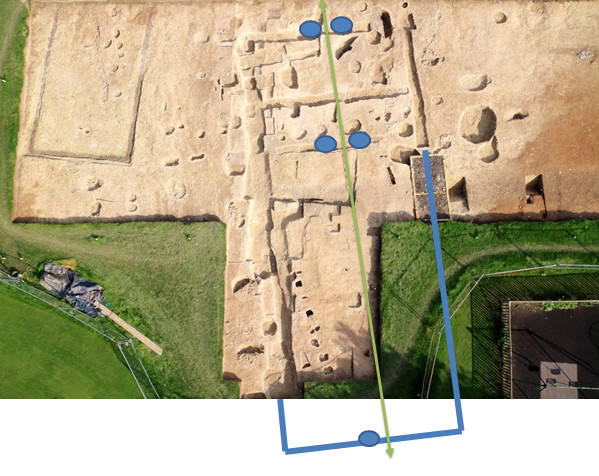
This picture from the 2014 excavations shows the alignment of the Timber Hall. The most westerly doorway (outside the photo) was excavated this year, in the 2015 excavations, proving the length of the building and the carefully ordered alignments of buildings within the ritual complex

Plan of the 2012-2014 excavations. The blue arrow indicates the carefully planned line-of-sight between the doorways of the north-south and east-west Timber Halls. Click to enlarge image.
Not only is this structure carefully proportioned and balanced architectually, the entire complex of buildings excavated on Tayne Field line up beautifully. There is a line-of-sight from the western end of this Timber Hall, all the way through to the impressive doorway pits excavates in 2013 in the north-south timber hall. We have at Lyminge an example of the ‘ritual symmetry’ excavated at other impressive Anglo-Saxon royal sites such as Cowdery’s Down, Hampshire, and Yeavering, Northumberland.
Finding both the end wall and part of the doorway is a fantastic result and clearly answers one of our objectives for returning to Lyminge this summer. But what of the midden, or the ‘blob’ that I’ve been blogging about throughout August? One of the major questions was the origins of the huge crater-like feature filled with Anglo-Saxon artefacts and the waste from industrial processes like iron smithing and smelting. If you’ve been following the blog, you’ll know that we established that the midden pit was most likely a natural geological feature called a solution hollow or a doline reasonably early on – these are types of sinkholes common to chalk and limestone geology. Because of the slow silting up of the pit, there are flints within the lowest layers of the midden, so we also know that the pit was open in prehistory, most likely sometime in the Bronze Age.
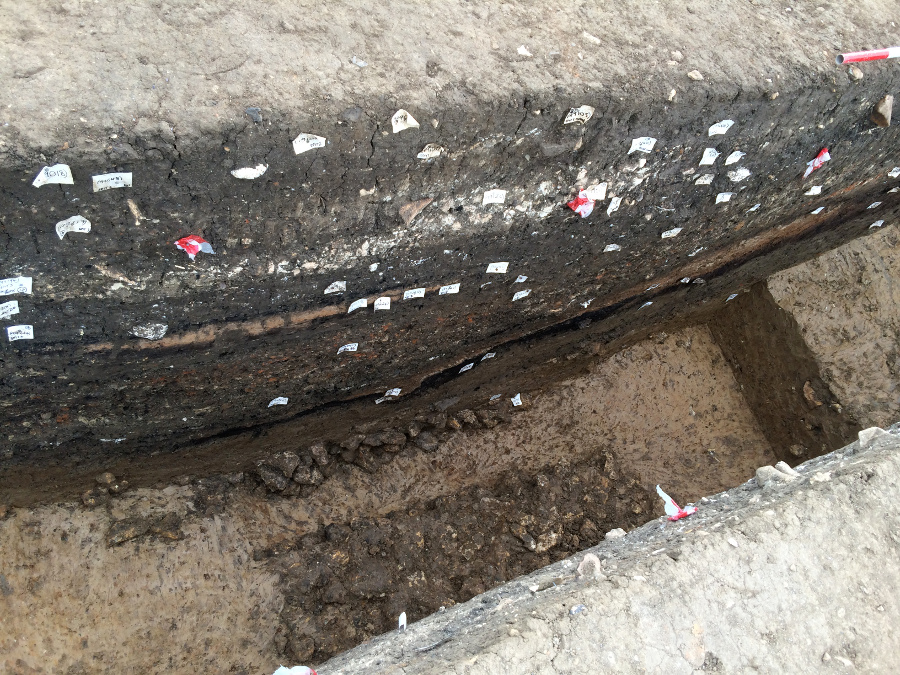
The layer of flint nodules revealed in 2014, with a section removed to indicate depth and what lies beneath. The full extent and origin of the flints was not at all clear at this stage
Our final question was what on earth the flints (see above) in the lowest Anglo-Saxon layers were doing there. In 2014 we were able to open a 1 m wide slot revealling a layer of what appears to be carefully laid flint nodules in the bottom of the midden.

The flints in our southern north-south trench through the ‘blob’, which seem to trail off rather than have a defined edge
This year, we returned to try and get an answer, and on the very last day of digging we appear to have done just that. While the southerly north-south slot only revealed a gradual petering out of the flints, the northern 2 m wide slot that was newly opened this season at last revealed a flint layer running all the way from the top to the bottom of the blob! Our team worked hard in the last days and even hours to fully reveal this flint ‘ramp’ or ‘pavement’.
These flint nodules run from the top north edge of the ‘blob’ and slope down quite steeply into the bottom of our excavated slots. This ‘pavement’ of sorts is only about one or two nodules thick, with smaller flints at the top edge, getting larger as you go down the slope. This suggests to us that they were carefully laid, although there are competing arguments as to whether they could be a natural phenomenon.
Sink holes or dolines such as the one we have excavated have been found in other areas with flint pavements, although a comparative example excavated at Thanet Earth in 2007-8 is less densely packed than at Lyminge, and much less well sorted.
Finds and radiocarbon dates (gathered in 2014) point very much to an Anglo-Saxon use, and the flints are ideal for gaining access to the bottom of the pit without slipping – as we all found out! The southern north-south slot was a slippery nightmare, while the north side with the flints was incredibly easy to negotiate. Although there is certainly an argument for the flints being natural, it looks very much to us like we have either carefully laid flints, or a natural flint area relaid or managed by the Anglo-Saxons to enable entrance to the pit – perhaps even to aid the quarrying of the good quality clay that built up slowly after the sinkhole was formed.
We were thrilled to be able to answer all the questions we came back to Lyminge with – it’s not often in archaeology that you get to answer every research question you set! Usually you come up with more questions than those that you answered, but although of course we have lots of new questions that we hope our post-excavation process will answer, we’re immensely pleased that we had such a successful final season.
Gabor presented these findings at the annual end-of-dig lecture, which was fantastically well attended with old faces and new. In fact, the full extent of the flint pavement was only truly revealed the next and final day of the dig, so you heard it here first!
Gabor’s talk also showed some of our amazing finds. John and Rosemary Piddock provided us with exceptional photographs of the best of our finds (and indeed photographed every single ‘small find’ that came up this summer).
Something I have repeatedly talked about in these blog posts is the sheer quantity of glass we have excavated, some 200+ fragments. The quantity and quality is unprecedented in a rural settlement site, and we’ll be focusing on this very much in our post-excavation process. We want to find out why our site has such a high proportion of glass compared to similar royal settlements like Yeavering.

A selection of the glass fragments found this year from both the midden and the timber hall (Photo by John Piddock)
As well as glass we had beautiful high status metalwork, with some pieces totally complete aside from the corrosion of centuries, another unusual feature. Lots of work will be done on this, and many of the objects are extremely datable and diagnostic, which will help us to build a picture of the years when the midden was in use.
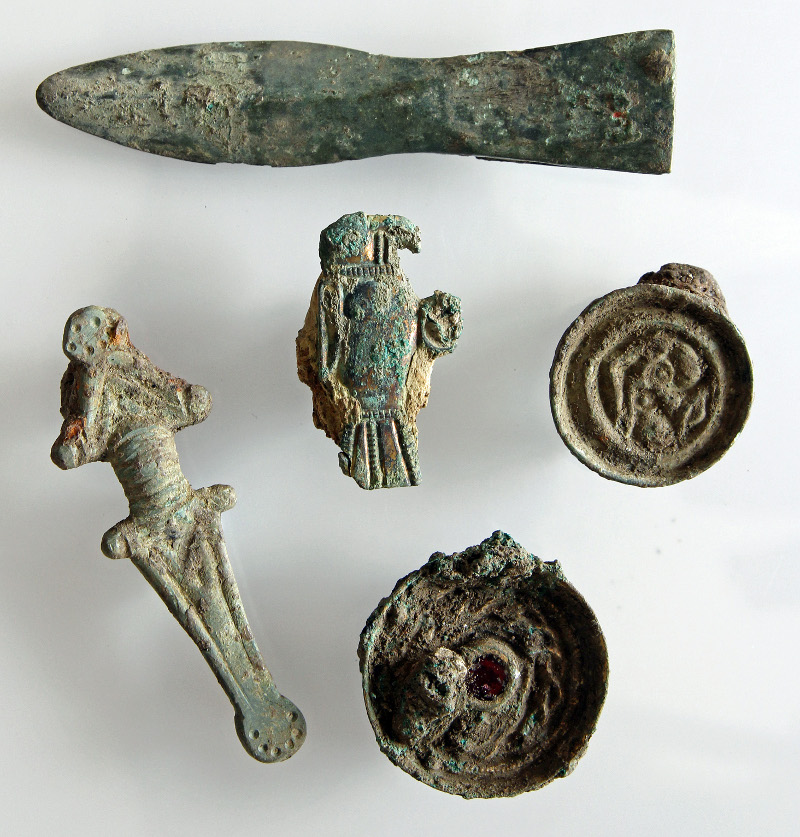
Some of the high quality copper alloy metalwork from this year’s excavations. Clockwise from top: A Frankish style strap-end from a belt, a button brooch, a garnet-inlaid disc brooch, a small-long brooch and in the centre a brooch in the shape of an eagle or a hawk (a raptor). (Photo by John Piddock)
This lovely bone comb (left) was also excavated from the midden, clearly broken at the rivet points, which is where you usually see breakages in these lovely objects. If you want to see more artefacts, you can look through the posts for August 2015 and you’ll see that this season, although short, wasn’t short on finds!
Something new for this year was the spectacular iron spear head (written about in an earlier post). It may not look like much here, but it is the very first identified example of weaponry from the settlement site at Lyminge, despite it’s extensive corrosion and the other materials that have corroded onto it.

Spear head, with extensive corrosion, the first weapon to be excavated from the settlement at Lyminge. (Photo by John Piddock)
The annual tradition of ‘Cake Friday’, continued, held on the last Friday of the dig. The ‘Lyminge Scrubbers’ as they call themselves, turned out some amazing treats for us all, as Gabor spoke some final words of thanks to our team and everyone who helped in any way at all make the excavations possible.
I can’t end this blog post without a mention of our amazing volunteers. Our finds washing team were as ever absolutely amazing, getting through masses of material, including last year’s left over unwashed finds! Everyone who dug, recorded, photographed, sieved, washed, dried, measured, drew and wheelbarrowed this summer was invaluable to the excavations and helped make the last four weeks digging in Lyminge a huge success.
There won’t be any further large excavations in the village, at least none run by us! The next stage is post-excavation, and there are lots of exciting plans for analysis, publication, dissemination, outreach, education and engagement. The project has submitted an application to the AHRC for funding for this next phase, and we will of course let you all know the results of that application. We hope very much to be back in the village telling you about our plans in a few months. Keep your fingers crossed for a good outcome!
That means that this isn’t goodbye, but merely a farewell until we can let you know how our post-excavation phase will work, and what plans we have for keeping the legacy of the excavations alive in Lyminge for future generations. Thank you all for your support over the past three years of digging and blogging, and for your continued support of the project!

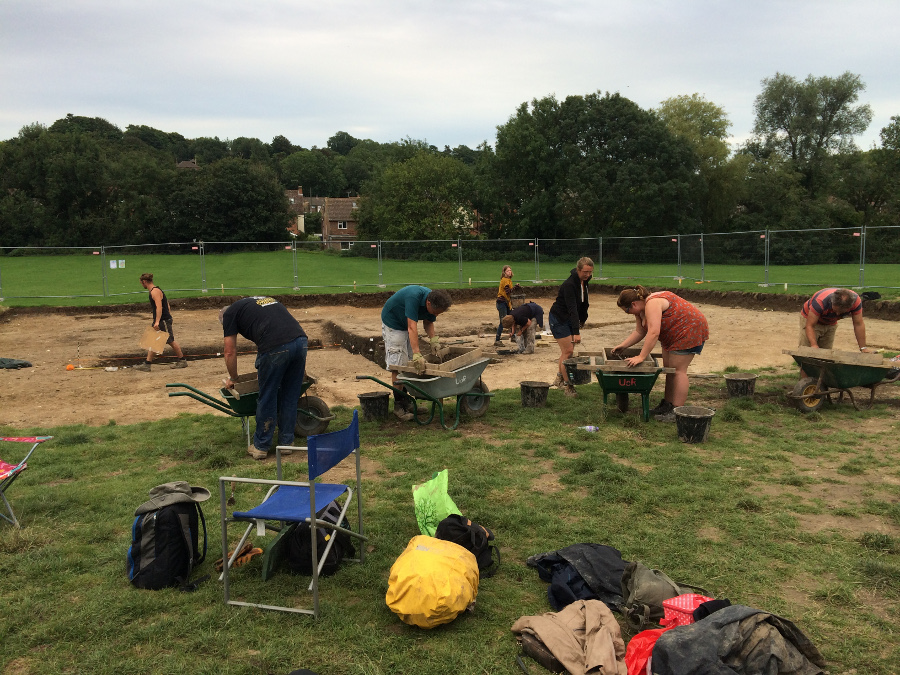
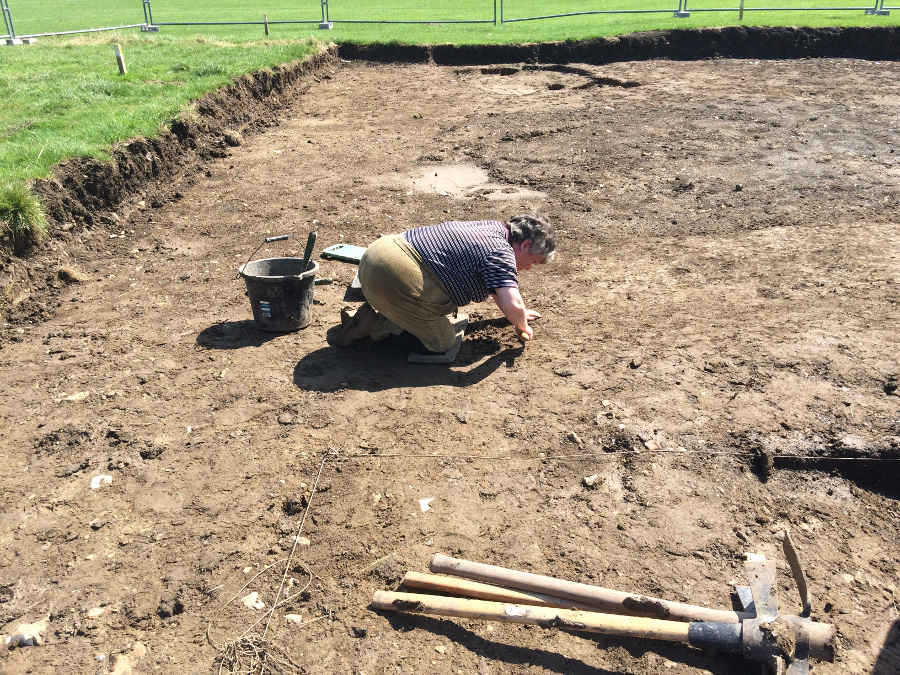







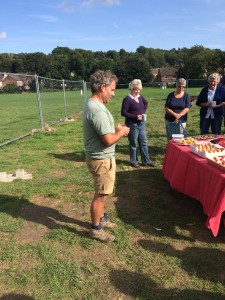
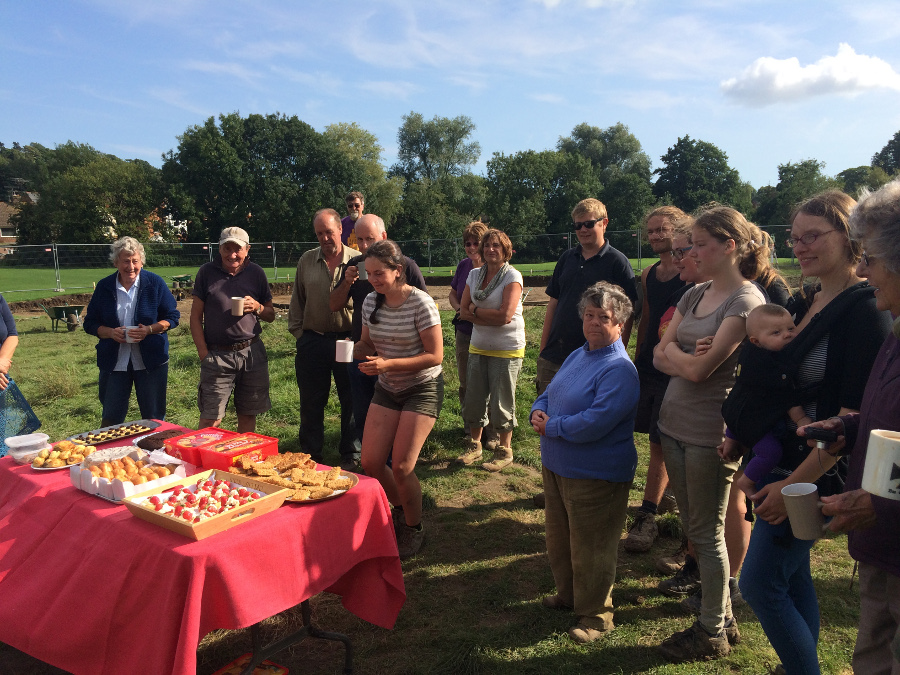
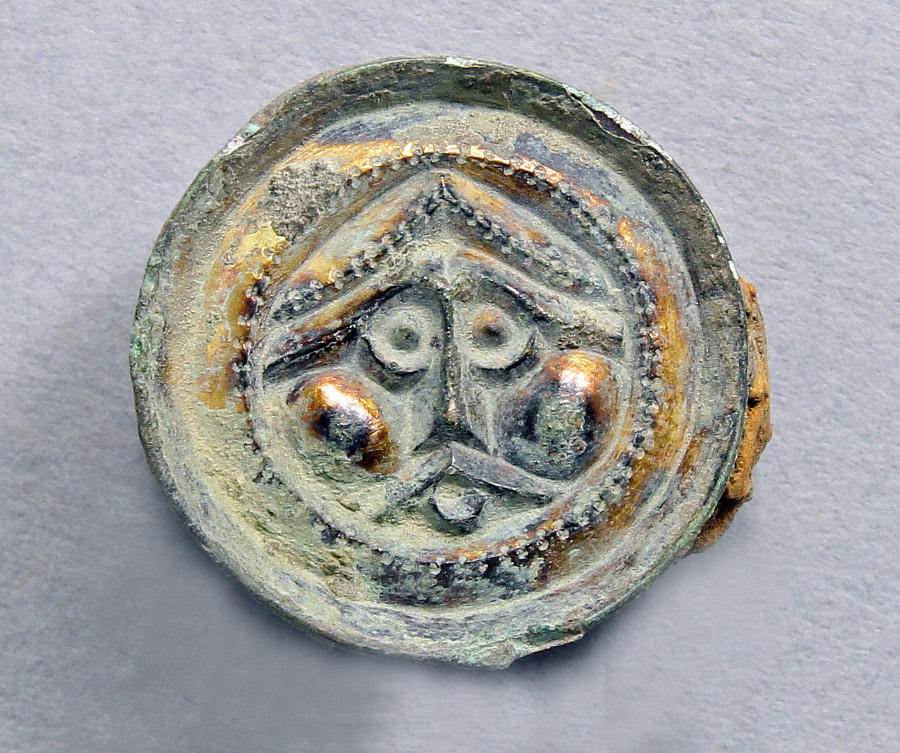
Thank you Alex, for all your informative posts. The Lyminge Dig as a whole and you and Gabor in particular have bought Archaeology to ordinary people and made it really understandable. Good luck with all your post dig work and thanks again
amazing as usual. wanted to come and dig but had to work. thanks for letting me come back and annoy you guys year after year xx